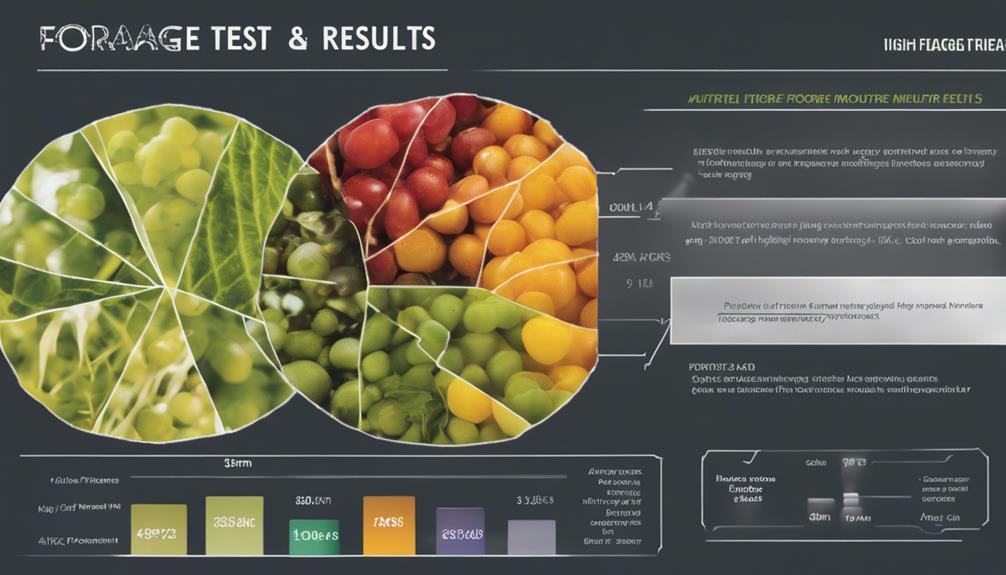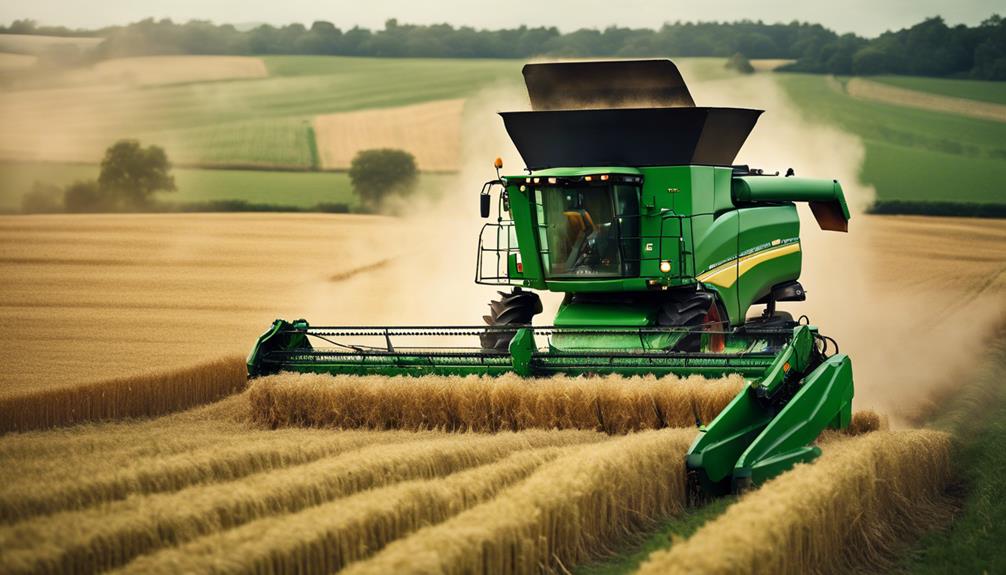To interpret forage test results effectively, pay attention to important nutrient parameters like protein, ADF, and NDF to ensure a well-rounded diet. Analyzing dry matter content after water extraction helps in accurate nutrient calculations. Understanding digestion metrics such as DMD and NDFD provides insights into forage quality. Evaluating energy content through TDN and net energy values assists in creating the optimal diet. Utilize the information to create personalized rations based on livestock requirements, boosting productivity. Knowing mineral values for supplementation is key. Enhance livestock performance with custom diets that improve health and efficiency. Delve into the details of forage tests for better livestock nutrition results.
Key Takeaways
- Understand protein, ADF, NDF, and mineral values for balanced nutrition.
- Analyze dry matter content accurately for consistent nutrient composition.
- Interpret digestibility metrics (DMD, NDFD) for effective diet formulation.
- Evaluate energy content (TDN, Net Energy) for optimal livestock productivity.
- Apply results to tailor feeding strategies for peak livestock performance.
Significance of Forage Test Results
Understanding the importance of forage test results is vital for optimizing livestock nutrition and performance. Forage analysis, including parameters such as protein and non-protein nitrogen, NDF, and ADF, plays a pivotal role in making informed feeding decisions.
By interpreting these test results accurately, you can tailor your animal's diet to meet their specific nutrient requirements, ultimately enhancing their overall performance and health. These results not only impact your animal's well-being but also influence your feed purchasing decisions, ensuring a cost-effective and balanced nutrition plan for your cattle.
Mastery of reading forage test results empowers you to identify and supplement any deficiencies in your herd's diet, leading to improved herd management and production efficiency. Investing time in understanding and utilizing forage test results can greatly benefit your livestock operation in the long run.
Key Nutrient Parameters to Analyze

To effectively assess the quality of forages for your livestock, it's imperative to analyze key nutrient parameters that directly impact their nutrition and overall performance. When conducting laboratory analysis, focus on important factors such as protein content. Crude protein levels are essential for animal growth, reproduction, and overall performance.
Additionally, evaluating acid detergent fiber (ADF) and neutral detergent fiber (NDF) values provides insights into digestibility, intake, and overall forage quality. These values help determine how well the forage will be utilized by your livestock.
Furthermore, considering macro minerals like calcium, phosphorus, and potassium is crucial to meet essential nutrient requirements in beef cattle diets. These minerals play a significant role in maintaining the health and productivity of your animals.
Understanding Dry Matter Content

Understanding dry matter content is essential in analyzing forage test results. This percentage represents the solid material remaining after removing water, allowing for accurate nutrient comparisons.
Dry Matter Importance
Dry matter content plays a pivotal role in forage analysis by determining the consistent nutrient composition. When you assess forage on a dry matter basis, you strip away the variability caused by moisture content, allowing for accurate comparisons of nutrient content between different feed ingredients. This is essential for ensuring ideal dry matter intake and formulating precise rations for livestock.
Understanding the dry matter percentage of forages is key to making informed feeding decisions and maximizing animal nutrition. By focusing on dry matter, you can effectively evaluate the true nutrient value of the feed, enabling you to provide your animals with a balanced diet that meets their specific needs.
Calculating Dry Matter
Calculating dry matter in forage analysis involves dividing the dry matter weight by the total weight and multiplying the result by 100 to express it as a percentage. Dry matter content is crucial for accurate nutrient evaluation in forages. It directly impacts nutrient concentration, with higher dry matter indicating more nutrients per unit weight. Understanding dry matter is key to formulating precise feeding strategies and ensuring excellent livestock nutrition. By calculating dry matter, you can adjust feeding strategies, evaluate forage quality, and make informed decisions regarding livestock nutrition.
| Dry Matter Content | Importance in Forage Analysis |
|---|---|
| High Dry Matter | Indicates more nutrients per unit weight |
| Low Dry Matter | May contain higher moisture content, diluting nutrient concentration |
| Calculating Dry Matter | Essential for accurate nutrient evaluation and feeding strategy adjustments |
Mastering dry matter calculations empowers you to interpret forage test results effectively, leading to improved feeding practices and better livestock health.
Interpreting Dry Matter
To grasp the significance of dry matter content in forage analysis, consider its impact on nutrient concentration and feeding strategies. Dry matter, a key element in forage testing and feed analysis, represents the percentage of nutrients present after eliminating water content.
Understanding dry matter is essential for accurate nutrient evaluation and developing balanced rations for livestock. By evaluating dry matter levels, one can effectively compare different forages and feedstuffs while ensuring consistent nutrient comparisons.
The dry matter content directly influences the nutrient density and feeding strategies in cattle diets, making it a critical factor in maximizing animal nutrition. Additionally, assessing forage quality heavily relies on dry matter content to make precise feeding decisions.
As such, interpreting dry matter accurately is essential for maximizing forage utilization, enhancing animal health, and achieving top performance in livestock production systems.
Interpreting Digestibility Metrics

Understanding how digestibility metrics like DMD and NDFD impact forage quality is essential for optimizing livestock nutrition. DMD reveals the proportion of digestible dry matter in forage samples, indicating the availability of nutrients for animals. On the other hand, NDFD evaluates the digestibility of cell wall components, influencing overall forage quality. By interpreting these metrics, you can assess how efficiently animals can extract nutrients from forages, guiding diet formulation for optimal livestock health and performance.
| Digestibility Metrics | Description |
|---|---|
| DMD | Measures digestible dry matter content in forages |
| NDFD | Assesses digestibility of fiber components in forages |
| Impact on Livestock | Higher DMD and NDFD values indicate better digestibility |
Evaluating Energy Content Indicators

When evaluating forage test results, analyzing energy content indicators is essential for optimizing livestock nutrition. Understanding the energy content overview, key indicators such as Total Digestible Nutrients (TDN), and how to interpret them provides valuable insights into the nutritional value of forages.
Energy Content Overview
Evaluating energy content indicators in forages is essential for optimizing livestock nutrition. The energy content of forages, derived from carbohydrates, proteins, and fats, plays a pivotal role in determining the overall quality of feed.
Total Digestible Nutrients (TDN) is a key indicator that represents the available energy after digestion, with TDN values typically ranging from 40-70% across different forage types. Net Energy values further refine the assessment, allowing for customized rations to meet specific production goals such as maintenance, growth, or lactation requirements.
Carbohydrates in forages, including both non-structural and structural forms, provide essential energy sources for livestock. While non-structural carbohydrates offer quick energy, structural carbohydrates ensure sustained energy levels, contributing to overall livestock health and performance.
Understanding these energy content indicators like TDN and Net Energy values is critical for formulating balanced diets that promote peak livestock productivity.
Key Indicators Explained
To effectively gauge the energy content of forages, key indicators such as Total Digestible Nutrients (TDN) and Net Energy values must be carefully examined. TDN reflects the energy value post-digestion, important for determining energy density in feeds. Higher TDN values signify more energy-rich forages suitable for diverse livestock production goals.
On the other hand, Net Energy values consider energy losses and specific livestock needs, aiding in precise ration formulation for best performance. Understanding these energy indicators like TDN and Net Energy values is essential for selecting forages that align with livestock energy requirements at different production stages.
Forage test results offer valuable insights into energy content through these indicators, facilitating informed decisions for balanced and efficient livestock nutrition. By interpreting these key indicators, you can tailor feed choices to meet the energy demands of your livestock, enhancing overall health and productivity in your operation.
Interpretation Tips
Check Total Digestible Nutrients (TDN) values first to assess the energy content available for your livestock in forage test results.
When analyzing forage test results for energy content indicators, consider the following tips:
- Understanding Net Energy values can provide insights into the specific energy sources present in the forage for the best livestock nutrition.
- Evaluate Dry Matter Digestibility (DMD) percentages to determine the proportion of dry matter in the forage that can be digested by livestock.
- Consider Neutral Detergent Fiber Digestibility (NDFD) measurements as they indicate the digestibility of fiber content in the forage, influencing overall energy availability.
- Comparing Relative Forage Quality (RFQ) values across different forages can help in selecting the highest-quality option based on energy, protein, and fiber content.
- Keep in mind the importance of nutrient intake for livestock health and productivity when interpreting energy content indicators in forage test results.
Assessing Forage Quality Metrics

Understanding forage quality metrics is essential for evaluating the nutritional value of forages for livestock consumption. Crude protein levels indicate the protein supply available to your animals in the forages.
Acid detergent fiber (ADF) and neutral detergent fiber (NDF) values reflect the fiber composition, digestibility, and potential intake of the forages.
Evaluating moisture content is important as it impacts nutrient balance and the dry matter basis of the forages, affecting overall quality.
By analyzing these metrics, you can determine forage digestibility, energy content, protein availability, and the overall nutritional value of the feed.
Paying attention to these factors allows you to make informed decisions when planning your livestock's diet.
Keep in mind that each metric plays a significant role in assessing the quality of the forages you provide, ensuring your animals receive the necessary nutrients for their health and well-being.
Applying Test Results to Feeding Strategies

When incorporating forage test results into your feeding strategies, you can adjust nutrient levels like protein and energy to meet your cattle's specific dietary needs. Understanding how fiber components like ADF and NDF influence digestibility and intake is essential for optimizing feeding programs.
To apply test data effectively, consider the following:
- Balanced Rations: Formulate diets that match the nutritional requirements of your cattle based on the protein (CP) and energy content per dry matter basis.
- Optimize Digestibility: Use the ADF value to assess the digestibility of forage, ensuring efficient nutrient utilization.
- Manage Intake: Utilize the NDF value to predict intake levels accurately, preventing under or overfeeding situations.
- Mineral Supplementation: Interpret mineral values to provide appropriate supplementation for essential nutrients like calcium and phosphorus.
- Stage-Specific Feeding: Tailor feeding plans to different production stages, adjusting energy levels for lactating cows to support their increased nutritional demands.
Enhancing Livestock Performance Through Analysis

To optimize your livestock's performance, analyzing forage test results is essential in tailoring diets for improved productivity and overall health. By delving into the nutritive value of forage crops through forage analysis, you can fine-tune livestock diets to meet their specific nutrient intake requirements.
This is particularly vital for beef cattle, where the right balance of nutrients directly impacts growth rates and feed efficiency.
Understanding the intricacies of forage analysis empowers you to make informed decisions that enhance livestock performance. Precise formulation of rations based on forage test results can lead to improved feed efficiency, better weight gains, and overall animal health.
Additionally, utilizing forage analysis effectively not only optimizes livestock productivity but can also result in reduced feed costs, ultimately boosting profitability.
Frequently Asked Questions
How to Read a Forage Test?
To read a forage test, understand moisture, protein, fiber, and minerals. Learn about dry matter basis, protein quality, and energy values. Evaluate NDF, ADF, TDN, and RFQ for quality and nutrition. Guide feeding and improve livestock health.
How Can You Identify Good Quality Forage?
To spot high-quality forage, seek high protein levels at 12-18%, low ADF/NDF for easy digestion, TDN above 55% for energy, balanced calcium-to-phosphorus ratio, and elevated RFQ values for overall quality. Best choices guarantee happy livestock.
What Are the Techniques for Forage Quality Testing?
To test for forage quality, you can use visual assessment, near-infrared spectroscopy (NIRS), wet chemistry analysis, and forage microscopy. These methods help determine protein, fiber, moisture content, nutrient composition, and plant species in forage samples.
What Is the Ideal Forage Analysis?
To nail ideal forage analysis, focus on moisture, protein, fiber (ADF/NDF), & minerals for precise nutrient evaluation. Dig into energy sources like TDN & quality factors (RFQ) to determine nutritional value. Make informed feeding choices!
Conclusion
By mastering the art of reading forage test results, you can discover the key to optimizing your livestock's nutrition and performance.
By analyzing nutrient parameters, understanding dry matter content, and interpreting energy indicators, you can craft feeding strategies tailored to your animals' needs.
With a keen eye for detail and a commitment to continuous improvement, you can elevate your farming practices and guarantee the health and well-being of your livestock.
Mastering forage testing is the pathway to prosperity on your farm.










